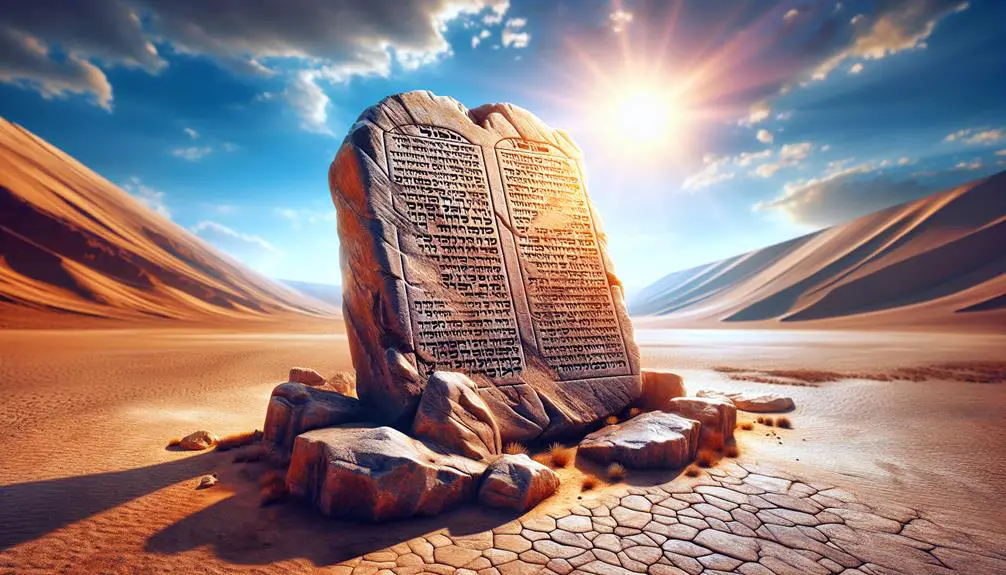Unlock the hidden meanings of water, fire, and wind in the Bible, revealing a world where every element tells a divine story.

Elements in the Bible
You might think that discussing elements like water, fire, and wind in the Bible is purely academic, but it's far more intriguing when you see them as symbols woven into the fabric of spiritual narratives. These elements aren't just background scenery; they carry deep symbolic meanings that enhance our understanding of biblical teachings.
From the cleansing power of water to the guiding light that represents divine knowledge, each element opens up a layer of interpretation that bridges the ancient text with contemporary relevance. As we explore these symbols, you'll uncover insights that could shift your perspective on familiar stories and perhaps even on life itself.
Key Takeaways
- Symbolic elements like water, fire, and wind in the Bible represent divine presence, guidance, and transformative power.
- Nourishment symbols such as bread and oil convey theological insights into faith, sustenance, and communal rites.
- Light and stone symbolize divine revelation and the enduring foundation of faith and law in biblical narratives.
- Blood serves as a cornerstone symbol for sacrifice, covenant, and redemption, highlighting the spiritual depth of atonement.
Water: Symbol of Life

Throughout the Bible, water consistently symbolizes life, marking moments of transformation and renewal that speak directly to the human experience. This connection between water and life's spiritual journey is deeply embedded in the biblical narrative, offering a rich tapestry of meanings that resonate across various contexts.
You'll find that water baptism stands as a pivotal rite within Christian traditions, symbolizing the believer's purification and rebirth. This act isn't merely a ritual but a profound declaration of faith and a step towards spiritual renewal, encapsulating the transformative power of water as conceptualized in biblical texts.
Moreover, the flood narratives, most notably Noah's story, further underscore water's dual role as both a force of destruction and a medium of purification. These stories convey a powerful message about divine judgment and mercy, illustrating how water can wipe the slate clean, setting the stage for a new beginning. It's this nuanced portrayal of water as an agent of both demise and renewal that deepens its symbolic significance within the biblical canon.
Analyzing these elements, you'd recognize that the biblical representation of water transcends its physical properties, embodying spiritual truths about cleansing, rebirth, and salvation. The narrative invites you to contemplate water's role in your own life, not just in a literal sense but as a metaphor for moments of significant personal or communal transformation. Hence, the biblical portrayal of water isn't just about historical or mythological events but about offering a lens through which to view the ebb and flow of human existence itself.
Fire: Divine Presence

Just as water symbolizes renewal and purification in the biblical narrative, fire, too, embodies divine presence, signifying both judgment and guidance. You'll find that fire rituals and fiery judgment are recurrent themes, deeply interwoven with God's interaction with humanity.
Fire serves as a multifaceted symbol. Initially, it represents God's presence. Think of Moses and the burning bush, where fire signified God's call and promise. Similarly, the pillar of fire leading the Israelites through the desert at night emphasized divine guidance and protection.
Yet, fire also connotes judgment and purification. The destruction of Sodom and Gomorrah with fire from heaven illustrates a direct fiery judgment upon wickedness. This aspect of fire reflects God's righteousness and justice, purifying the earth from sin.
Analyzing fire's dual role enriches our understanding of its symbolism. Fire rituals, like burnt offerings, served as an atonement method, illustrating both aspects of fire—seeking God's presence and guidance while acknowledging His right to judge.
Aspect |
Example |
Significance |
|---|---|---|
Guidance |
Pillar of fire |
Divine leadership |
Judgment |
Sodom and Gomorrah |
Punishment for sin |
Presence |
Burning bush |
God's call and promise |
Ritual |
Burnt offerings |
Atonement and worship |
This table encapsulates fire's complexity in the biblical narrative, underscoring its role in showcasing God's multifaceted character. As you delve deeper, you'll appreciate how fire's portrayal offers profound insights into the divine-human relationship, marked by guidance, judgment, and presence.
Bread: Sustenance and Communion

You'll find that bread carries profound symbolic weight in biblical narratives, serving not just as a basic necessity for life but also embodying spiritual sustenance.
The 'Bread of Life' symbolism and the rituals of breaking bread encapsulate both physical and divine nourishment, fostering a communal bond among believers.
These practices underscore the multifaceted role of bread in connecting the faithful to the divine and to each other, reflecting broader themes of provision, fellowship, and salvation.
Bread of Life" Symbolism
In the Bible, the symbolism of the 'Bread of Life' conveys profound theological insights into the concepts of sustenance and communion, reflecting a foundational element of Christian faith and practice. This metaphor extends beyond physical sustenance, embodying Eucharistic parallels that bridge the tangible with the spiritual realm.
You're invited to contemplate how this emblem of spiritual nourishment transcends mere aliment to embody Christ's presence and sacrifice. The 'Bread of Life' discourse, primarily found in the Gospel of John, emphasizes Jesus as essential for spiritual survival, echoing the manna provided to the Israelites as both a physical and spiritual sustenance.
This rich symbolism fosters a deeper understanding of faith's sustenance, urging believers to partake in the divine communion that nourishes soul and spirit.
Rituals of Breaking Bread
Exploring the rituals of breaking bread reveals a multifaceted practice deeply embedded in the fabric of religious and communal life, symbolizing both sustenance and profound spiritual communion. This act transcends the mere act of eating, embedding itself in the very essence of community and faith.
- Eucharistic Origins: The Last Supper establishes the groundwork, where Jesus' breaking of the bread and declaration of it as His body introduces a sacred tradition.
- Communal Implications: This ritual fosters a sense of unity, embodying the idea that sharing a meal is sharing life itself.
- Symbolic Resonance: Beyond physical nourishment, breaking bread serves as a metaphor for divine provision and fellowship among believers.
You're invited to reflect on how these practices shape your understanding of community and spirituality, recognizing their enduring significance.
Wind: Spirit and Breath

How does the Bible conceptualize wind, viewing it not merely as a natural phenomenon but as a symbol of spirit and breath? In biblical literature, wind serves multiple symbolic purposes, notably in the realms of navigation and judgment. It's pivotal to understand that the ancient Hebrew term 'ruach' can mean both wind and spirit, illustrating the intrinsic connection between the two in the biblical worldview.
In terms of navigation, wind in the Bible often signifies divine guidance or intervention. You'll find stories where a wind sent by God leads characters to their destinies or provides a path through seemingly insurmountable obstacles, like parting the Red Sea for the Israelites. This symbolic use underscores the belief in a God who actively navigates the course of human lives and history.
On the other hand, wind as judgment represents God's power to bring about change or punishment. The prophets frequently speak of winds sent by God to scatter enemies or bring ruin upon nations that have strayed from His commands. Here, wind embodies the breath of God as a force of divine retribution, reminding you of the power and sovereignty of the divine.
This dual symbolism enriches your understanding of biblical narratives, highlighting the complexity of God's interactions with the world. Wind, as spirit and breath, is a potent symbol of God's presence, guidance, and judgment, weaving through the text to reveal deeper layers of meaning about the divine-human relationship and the nature of spiritual life.
Light: Knowledge and Purity

Throughout biblical texts, light frequently symbolizes knowledge and purity, serving as a divine beacon that guides humanity towards truth and moral clarity. This motif not only elevates light to a spiritual status but also engages in a form of light warfare against the forces of darkness, underscoring a perennial contrast that threads through the fabric of biblical narratives.
In this context, you'll find that light's emblematic presence is multifaceted, reflecting various dimensions of divine interaction with the world:
- Light as Divine Revelation: It's often portrayed as a medium through which God reveals His will and wisdom to His people, illuminating the path of righteousness in a world ensnared by moral obscurities.
- Light versus Darkness: This dichotomy serves as a powerful metaphor for the battle between good and evil, with light representing the purity and holiness of God's presence and darkness symbolizing sin and ignorance.
- Light as Purification: Beyond its illuminative function, light also symbolizes the process of purification, where divine light burns away impurity, leaving behind only what's pure and holy.
Analyzing these elements, it's clear that the biblical depiction of light extends beyond a mere physical phenomenon. It's intricately linked with knowledge, purity, and a divine mission to dispel darkness. The contrast between light and darkness further accentuates this role, framing light not just as a passive symbol of goodness but as an active participant in the cosmic struggle between truth and deception, purity and impurity. This light warfare encapsulates the essence of light's symbolic significance in the Bible, embodying the relentless pursuit of divine truth and moral clarity in the face of darkness and ignorance.
Stone: Law and Foundation

Just as light serves as a divine guide towards purity and knowledge, so too does stone symbolize the steadfast laws and foundational truths in biblical narratives. Stone construction and ceremonial stones are pivotal elements that provide both a literal and metaphorical foundation for understanding the complex relationship between divine commandments and human society.
In the context of stone construction, consider the Ten Commandments, inscribed on stone tablets by God and given to Moses on Mount Sinai. This act solidifies stone as a medium for the immutable laws that are meant to guide the moral and ethical conduct of humanity. The durability of stone serves as a metaphor for the eternal nature of these divine laws, suggesting that they're unchanging and foundational to human existence.
Ceremonial stones, on the other hand, play a significant role in marking sacred spaces and moments. Jacob's setting up a stone pillar at Bethel as a memorial of his encounter with God illustrates how stones are used to commemorate divine promises and revelations. These stones aren't just physical markers; they're imbued with spiritual significance, representing moments of covenant and divine intervention in human history.
Analyzing these uses of stone in the Bible, you'll notice that they aren't merely architectural or decorative. They're deeply symbolic, embodying the unyielding truth of God's word and the solidity of faith. Whether as lawgivers or as memorials, stones in biblical narratives are foundational to understanding the covenant between God and humanity, serving as enduring reminders of divine presence and guidance.
Oil: Anointing and Healing

As you transition from the symbolic resonance of stone within biblical narratives to the multifaceted role of oil, it's essential to recognize its dual significance in anointing and healing.
The ritualistic application of oil not only consecrates individuals, distinguishing them for spiritual service or kingship, but also underscores oil's therapeutic properties, reflecting a tangible manifestation of divine favor and intervention.
Analyzing these dimensions reveals oil's integral function in both communal and individual rites, illuminating its profound spiritual and physical implications across biblical texts.
Biblical Significance of Oil
Oil, symbolizing both anointing and healing, holds profound significance in biblical narratives, serving as a multifaceted symbol of consecration and divine favor. Embedded within its usage are layers of oil economics and cultural uses, which underscore its value and versatility in ancient societies. You'll find that oil's significance isn't only spiritual but also deeply entrenched in the socio-economic fabric of biblical times.
- Oil economics: It was a valuable commodity, central to trade and economic stability.
- Cultural uses: Beyond religious ceremonies, oil played a crucial role in daily life, from cooking to skincare.
- Symbol of consecration: Kings, priests, and prophets were anointed with oil, marking them as chosen by God and setting them apart for sacred duties.
This dual role of oil illustrates its integral place in both divine and mundane aspects of life.
Oil's Healing Properties
Beyond its symbolic significance, oil also possesses remarkable healing properties that were well recognized and utilized in biblical times. Its application went beyond mere anointing rituals, delving into the realms of cosmetic use and medicinal healing.
Scholars have noted that oil served not only as a balm for physical ailments but also as a means to protect and nourish the skin, showcasing its dual purpose. The economic value of oil, therefore, surged, as it became an essential commodity in ancient societies. Its ubiquity in healing practices underlines the ancients' adept knowledge in harnessing natural resources for comprehensive well-being.
Analyzing the scriptural references, it's evident that oil's healing properties weren't merely incidental but deeply embedded in the cultural and economic fabric of biblical times.
Blood: Sacrifice and Covenant

In the biblical narrative, blood serves as a foundational symbol for both sacrifice and covenant, embodying deep theological and spiritual significance. It's a vessel through which you can explore profound truths about humanity's relationship with the divine. Specifically, the concept of blood lineage and its use as a redemption metaphor are pivotal in understanding the multifaceted role blood plays within scripture.
- Blood Lineage: This concept underscores the importance of familial and tribal connections in the Bible. Blood ties aren't just biological but carry heavy spiritual and covenantal implications, affecting one's identity and obligations within God's unfolding plan.
- Sacrificial System: In the Old Testament, the sacrificial system instituted by God required the shedding of blood as atonement for sin. This practice illustrated the severe consequences of sin and the extreme measures required for reconciliation with God.
- New Covenant in Christ: The New Testament reinterprets and fulfills the symbolism of blood through the ultimate sacrifice of Jesus Christ. His blood, shed on the cross, is presented as the means for humanity's redemption, establishing a new covenant that supersedes and perfects the old.
Through these lenses, blood in the Bible isn't merely a physical substance but a rich symbol that communicates God's intentions for humanity—judgment, mercy, and ultimately, redemption. You're invited to delve deeper into this symbol, recognizing its significance in the narrative of salvation history. Blood, in its essence, bridges the gap between a holy God and a fallen humanity, offering a path to restoration and eternal communion.
Frequently Asked Questions
How Do the Elements in the Bible Reflect the Cultural and Environmental Context of the Times?
In analyzing historical texts, you'll find that elemental symbolism offers a rich lens for understanding cultural and environmental influences.
For instance, water often symbolizes purification or chaos, reflecting societal values and natural challenges.
By dissecting cultural interpretation of these elements, you're peeling back layers of historical context.
This approach reveals how communities of the time viewed their world, merging the physical with the spiritual in a tapestry of meaning and belief.
Are There Any Elements Mentioned in the Bible That Have Been Interpreted Differently Over the Centuries?
Yes, many elements mentioned have indeed been interpreted differently over time. It's fascinating how elemental symbolism and historical interpretations evolve.
You'll notice that as societies change, so do the meanings they attach to these elements. This shift in understanding highlights the dynamic relationship between text and context.
Analyzing these changes offers you a deeper insight into not just the text's significance, but also its adaptability and relevance across various cultural and temporal landscapes.
How Do the Elements in the Bible Relate to Modern Scientific Understandings of the Natural World?
When you dive into how ancient texts parallel with modern science, you'll find fascinating intersections and stark scientific discrepancies. Elemental symbolism, often rich in these texts, doesn't always align with current scientific knowledge.
This discrepancy invites a deeper analysis, challenging you to consider the symbolic meanings attributed to elements and how they compare to our contemporary understanding of the natural world.
It's a compelling blend of historical belief systems and modern scientific discoveries.
What Role Do the Elements Play in the Prophetic and Apocalyptic Literature of the Bible?
In prophetic and apocalyptic literature, elements are often symbolic, showcasing divine control over nature. They're not just background scenery; they serve as tools for elemental punishments or blessings, reflecting a deity's will.
This literary technique emphasizes the power and authority of the divine, making the narrative both awe-inspiring and a warning. You'll see elements manipulated in ways that underscore their significance in conveying messages of judgement or salvation.
How Have the Symbolic Meanings of These Elements Influenced Christian Liturgy and Artistic Representations Throughout History?
You're delving into how symbolic meanings have shaped Christian traditions and art over centuries. These symbols, deeply rooted in early texts, have left a lasting impact on liturgical garments and choir compositions, reflecting a rich tapestry of spiritual and historical narratives.
They've not only influenced the aesthetic but also the theological framework, weaving a complex interplay between visual, musical, and ritualistic elements that continue to define and enrich the Christian liturgical experience.
Conclusion
In exploring the Bible's elemental tapestry, you've journeyed through water's flowing vitality, felt the searing touch of divine fire, and broken bread in spiritual communion.
You've been caressed by the whispering wind of the spirit, basked in the illuminating glow of light, stood firm on the foundational stone of law, and experienced the sacred anointing of oil.
Finally, you've contemplated the profound covenant sealed in blood. These elements aren't mere symbols; they're the very essence of life's divine narrative, intricately woven into our spiritual and existential understanding.



Sign up